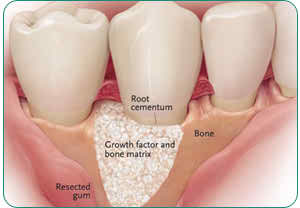
Bone Grafting/Sinus Lift
"I have to drive a distance to see Dr Khan. Having a very busy and over scheduled life it would be easier to change to a closer dentist but with the quality of care and amazing staff that is here I would not consider changing dentists."
-- Karen-Bohaboy G

Causes for Jaw Bone Volume Shrinkage

- Periodontal Disease – Periodontal disease can affect and permanently damage the jaw bone that supports the teeth. Affected areas progressively worsen until the teeth become unstable.
- Tooth Extraction – Studies have shown that patients who have experienced a tooth extraction subsequently lose 40-60% of the bone surrounding the extraction site during the following three years. Loss of bone results in what is called a “bone defect”.
- Injuries and Infections – Dental injuries and other physical injuries resulting from a blow to the jaw can cause the bone to recede. Infections can also cause the jaw bone to recede in a similar way.
Bone grafting can repair implant sites with inadequate bone structure due to previous extractions, gum disease or injuries. The bone is either obtained from a tissue bank or your own bone is taken from the jaw, hip or tibia (below the knee.) Sinus bone grafts are also performed to replace bone in the posterior upper jaw. In addition, special membranes may be utilized that dissolve under the gum and protect the bone graft and encourage bone regeneration. This is called guided bone regeneration or guided tissue regeneration.
Major bone grafts are typically performed to repair defects of the jaws. These defects may arise as a result of traumatic injuries, tumor surgery, or congenital defects. Large defects are repaired using the patient’s own bone. This bone is harvested from a number of different sites depending on the size of the defect. The skull (cranium), hip (iliac crest), and lateral knee (tibia), are common donor sites.
Five titanium implants are placed in the jaw in such a way that the bone will envelop and secure them into place. The implants that are placed in the back part of the jaw are angulated to achieve maximum advantage to the existing bone structure. Once the five implants are secure, the abutments will be attached so that the replacement teeth can be fastened and adjusted for maximum comfort and function giving you a brand new radiant smile. Because only 5 implants are used in the procedure, the entire process is much less invasive and involves less surgical time than previous treatments.
The beauty of this new procedure is the sheer convenience. Special implants were developed for this treatment allowing for the immediate fitting of replacement teeth to the abutments. This means that with only five implants, patients can leave their dental office with a full set of new replacement teeth within only one appointment! No bone grafts necessary! The teeth are permanent and fixed so there is no need for patients to be without teeth or to endure temporary dentures for an extended time period. The patient is enabled to come for a morning appointment and leave that same afternoon with a brand new radiant smile!
Previous treatments required patients to receive a total of six or more implants, with treatment extending throughout 18 months of treatment. The patients were then forced to leave the office without any teeth or a poor fitting temporary denture for over a year! With the All-on-5 procedure, we make sure our patients leave our office smiling- with a brand new set of replacement teeth!
Sinus Lift

The maxillary sinuses are behind your cheeks and on top of the upper teeth. Sinuses are like empty rooms that have nothing in them. Some of the roots of the natural upper teeth extend up into the maxillary sinuses. When these upper teeth are removed, there is often just a thin wall of bone separating the maxillary sinus and the mouth. Dental implants need bone to hold them in place. When the sinus wall is very thin, it is impossible to place dental implants in this bone.
There is a solution and it’s called a sinus graft or sinus lift graft. Our dentist enters the sinus from where the upper teeth used to be. The sinus membrane is then lifted upward and donor bone is inserted into the floor of the sinus. Keep in mind that the floor of the sinus is the roof of the upper jaw. After several months of healing, the bone becomes part of the patient’s jaw and dental implants can be inserted and stabilized in this new sinus bone.
The sinus graft makes it possible for many patients to have dental implants when years ago there was no other option other than wearing loose dentures.
If enough bone between the upper jaw ridge and the bottom of the sinus is available to stabilize the implant well, sinus augmentations and implant placement can sometimes be performed as a single procedure. If not enough bone is available, the Sinus Augmentation will have to be performed first, then the graft will have to mature for several months, depending upon the type of graft material used. Once the graft has matured, the implants can be placed.
Contact us today to schedule a consultation.
